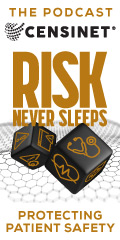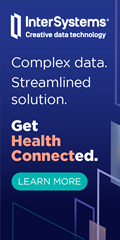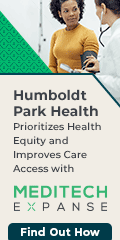Curbside Consult with Dr. Jayne 12/16/19

Winter has arrived in the Midwest, and with it the end-of-year slowdown in healthcare IT news. While sales-focused teams are scurrying to complete end-of-quarter sales to bolster their final financials, marketing folks seem to be holding anything remotely interesting until we get closer to HIMSS. That leaves us with a smattering of governmental and regulatory news items.
I admit sometimes I miss these kinds of items because of the noise of all the other things going on in the industry, so maybe it’s a good thing that we’re headed into a less-frantic time (at least until March, that is).
Sneaking into the news on Friday was the FDA approval of Tandem Diabetes Care’s predictive software that bridges the gap between continuous glucose monitors and the company’s insulin pump. Why is this a big deal? It’s the first insulin dosing software approved under a new FDA interoperability pathway, which gets interesting because different companies make components of the so-called “artificial pancreas” systems that result. You could be using one company’s glucose sensor, another’s pump, and a third-party algorithm between the two.
Tandem is already working with Dexcom Inc. and Abbott Laboratories to coordinate. This is great for patients whose insurance may only cover certain brands of one device or another, and who otherwise might not be able to take advantage of the newest technology. Typically payers only cover insulin pumps every four years, so being able to update a control algorithm rather than having to obtain a completely new device is a pretty cool thing.
Also in the news this week: glitches in the Healthcare.gov system where many people have to sign up for insurance coverage. It’s possible that up to 100,000 users were impacted by technical issues on the first day of open enrollment. CMS had to add a “waiting room” to the site to help manage traffic flow, and as of December 7, there have been 6 percent fewer enrollments compared to last year.
Patient advocates were concerned about the typical last-minute surge of enrollments and whether the site would be able to handle the traffic before the deadline. I haven’t seen any updated numbers this morning, but I’m sure there will be a lot of spin placed on whatever data becomes available this week.
A recent approval by the Federal Communications Commission is raising concerns. The group voted last week to create 988 as a nationwide suicide prevention hotline telephone number, much like 911 for emergency services. It would replace the existing number for the National Suicide Prevention Lifeline. The thought is that a shorter number would enable more people to call, but there are anticipated downsides: an increased number of callers would also increase the costs for crisis centers staffing those phones and many centers are struggling to make ends meet as it is.
The hotline is funded by the Substance Abuse and Mental Health Services Administration (SAMHSA). Theoretically more people would be calling 988 rather than 911, so that’s a cost savings since fire and emergency services won’t be dispatched for a potential suicide attempt. It could also lead to significant societal savings by preventing loss of life, but those savings aren’t immediately passed to those institutions bearing the cost, based on the calculus of healthcare math. Another example that healthcare is complicated, y’all.
Other government news includes the impending release of millions of dollars in disputed Medicare hospital payments that were withheld due to a payment policy that was struck down in court. The American Hospital Association estimates that $380 million will begin flowing as Medicare Administrative Contractors start reprocessing claims that were paid at reduced rates. Reprocessing begins January 1, so get your data and claims engines running!
Just when I thought I was out of government news, I came across news about the recent report by the US Department of Health and Human Services, Office of the Inspector General, regarding concerns around chart reviews looking at Medicare Advantage payments. Not surprisingly since billing is such a game, claims were reflecting sicker patients and more comorbid conditions than patients might actually have. Apparently payers are adding diagnosis codes for conditions that aren’t documented in physician or hospital records and this occurred in 99.3% of chart reviews.
Medicare Advantage is a big piece of the Medicare spending pie — approximately $210 billion of the $711 billion spent last year went to Medicare Advantage plans. There are concerns not only about overbilling, but that plans are functioning like the HMOs of the past to deny care as a means of increasing profits. There are also concerns that if the patients actually have the conditions added by payers (which aren’t reflected in the medical records) that patients aren’t receiving adequate care.
The audit looked at data from 2016 to assess the financial impact in 2017. As payers get more creative, it’s possible the problem could be even more rampant now. A particularly damning sentence from the report: “Although limited to a small number of beneficiaries, almost half of all Medicare Advantage organizations reviewed had payments from unlinked chart reviews where there was not a single record of a service being provided to the beneficiary in all of 2016.” At least fee-for-service payment models require the patient to be in front of you before you bill for services.
HHS recommends that CMS provide oversight of organizations that had payments resulting from chart reviews where beneficiaries received no services; conduct audits to validate diagnoses; and reassess the practice of allowing unlinked chart reviews being used as a source of diagnoses for determining risk. CMS accepted these recommendations.
There’s one piece of governmental news that’s front and center right now, although patients aren’t talking about it. Influenza is on the rise, with 2.6 million illnesses, 23,000 hospitalizations, and 1,300 deaths so far. I can’t count the number of patients who said “I never get the flu shot” a couple of months ago who are now showing up at the office sick and miserable. There’s not a lot we can do for influenza, other than providing supportive care and symptomatic relief. For small children, there’s even less we can do. Please do your part – wash those hands and stay home if you are sick. And next year, consider a flu shot.

Email Dr. Jayne.





















































































Nice article, but every time I saw the word "provider" (24 times), I felt demeaned. We are not "providers". How…